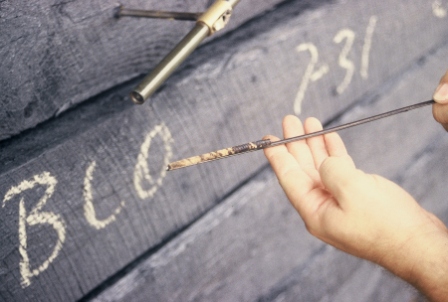The TieLife Model is used for the Determination of Wood Tie Life And Future Cross-Tie Requirements and is compatible with Windows operating systems. Welcome to the RTA TieLife model. This model is a user-friendly Windows application designed to determine tie life and forecast the number of ties required for replacement based on various track and operating characteristics. The user has the ability to define the operating characteristics (MGT, etc.) and track characteristics for analysis. Wood tie track is assumed as the existing track or base system. The model is designed to run on Windows 3.1 or higher. The RTA TieLife model’s primary function is to evaluate the tie life, and forecast the number of ties required for replacement on both the branch as well as on the main line tracks. The annual tie requirements and tie life are presented in the form of a matrix with five categories of curvature and seven categories of annual MGT on the railroad. Two distinct methods are used for determining the number of replacement ties; an empirical method and a statistical method based on previous tie replacement history. The model consists of five forms arranged in a tab format, which can also be accessed through the menu. Two forms allow the user to input the data and the remaining three forms display the results of the analysis. Each form is discussed in detail as follows. Input DataThe Input Data form contains the track and operating characteristics of the system of track being analyzed. This form has three different sections. The first section displays the track characteristics including the climate zone that the track being analyzed is in; the second section lists the fastener type in the tonnage/curvature distribution matrix; and the third section displays track miles and percentage of track mile in the tonnage/curvature distribution matrix. The tonnage/curvature distribution matrix consists of five categories of curvature (0.0-0.1, 0.1-3.0, 3.0-5.0, 5.0-8.0, >8.0) and seven categories of annual MGT (Secondary & Branch, Main: 0-10, 10-20, 20-30, 30-40, 40-50, >50) to provide a total of 35 inputs. This matrix is designed to incorporate the typical distribution of severity of track curves and tonnage over a system of track associated with a typical US freight railroad. Tie Installation HistoryThe tie installation history form shows the number of original installed ties for each of the last 40 years. The year of installation, installed track miles, annual MGT at the time of installation, and normalized installed ties for each year are also shown. The installed track miles, and installed MGT are calculated by the model based on the total track miles, and the total MGT on the system of track being analyzed. The normalized installed ties for a particular year are computed using the number of original installed ties, installed MGT, and installed track miles for that year. Tie LifeTie life in years is calculated for each of the categories in the tonnage/curvature distribution matrix. The different components involved in the calculation of tie life include MGT, curvature, and type of fastener (cut spike or elastic fastener). The life cycle of wood ties in a branch line, and a main line are assumed to be different. The initial life cycles for both the branch and main lines are assumed to be 50 and 35 years respectively. The initial life cycle is adjusted for the tonnage and curvature factors to obtain the tie life. Note; the climate zone is factored in the calculation of tie life for branch line tracks only. Annual Tie RequirementsAnnual tie requirements are calculated for each of the categories in the tonnage/curvature distribution matrix using an empirical method. The calculations are based on a steady state distribution using the average number of ties per mile for mainline and secondary & branch line tracks. The model calculates the total quantity of ties required for each year using the track miles and tie life for each category in the tonnage/curvature distribution matrix. ForecastThe model uses the historical distribution of tie replacements for the past 40 years to forecast the number of ties required per year for replacement using the statistical method. The forecast is calculated for the following 21 years from the current year. The different components used in the calculation include the average tie life, and constants for cumulative frequency curves of forest products treated data. Contact the Railway Tie Association to purchase either SelecTie II or |


